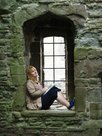Framlingham Castle, Suffolk
Location | Church Street, Framlingham |
Road | B1119 / B1120 |
SatNav | IP13 9BP |
The magnificent curtain walls of Framlingham are amongst the best preserved in Britain, over 8 feet thick, 44 feet tall with 12 flanking towers. Built by the powerful Earl of Norfolk, Roger Bogod who, together with his successor's, had tempestuous relationships with their kings.
Built on the site of an earlier timberwork castle raised by Roger's grandfather, destroyed by Henry II, its final completion must have seemed a resounding proclamation of Bigod independence to King John when he stayed there as a guest and returned three years later to besiege it.
The Bigod family, however, continued as rebels and were not crushed until Edward I removed the last of them.
Thereafter it became for a while the chief seat first of the Mowbrays and then the Howards, dukes of Norfolk, with periodic forfeiture to the Crown. It was during one of these interludes in the Howard's ownership that Princess Mary - threatened by the uncertainty which followed the death of her brother King Edward VI - came here to stay, and it was here that the Earl of Arundel arrived to inform her that she was Queen of England. Mary then raised her standard over the gatehouse and assumed the title.
We thoroughly enjoyed our visit to Framlingham Castle, as there is plenty to see as the curtain walls are still in good repair, enabling a walk around the battlements possible, which always provides a great view and exploring of any castle.
The house is of great interest as is a walk around the outside of the castle, exploring the earthworks and ditches.
~ History ~
1086 - The Domesday book records Roger Bigod as tenant of Framlingham to Hugh, Earl of Chester.
1148 - Hugh Bigod entertains Theobald, Archbishop of Canterbury, in the timber and earthwork castle.
1157 - King Henry II confiscates the castle.
1165 - Framlingham is returned to the Bigod's.
1177 - Following the eighty year old Hugh's part in the rebellion by King Henry's sons against the him, the King orders Aldnodus the engineer to demolish the castle for the sum of £14 and 15 shillings.
1189 - King Richard I allows Richard Bigod to re-occupy and rebuild Framlingham in stone. The curtain walls are first to be built.
1213 - Roger Bigod entertains King John at the castle.
1216 - Following Roger's decision to join the barons rebellion against John, the King besieges and captures the castle.
1246 - The Bigod's are made Earl Marshall's by Henry III but later lose this title when another Roger Bigod refuses to serve Edward I in Gascony. Upon his death the castle reverts to the Crown.
1312 - Edward II grants the castle to his half-brother Thomas de Brotherton. His heiress brings the estates to Thomas Mowbray.
1397 - Thomas is created Duke of Norfolk by Richard II.
1399 - Thomas is exiled for his part in a private war.
1405 - His son is executed by King Henry IV and custody of the castle is given to Prince Henry.
1425 - Thomas's second son regains the Dukedom and resides at Framlingham.
1461 - John, the 4th Duke of Framlingham, besieges and captures nearby Caister Castle.
1476 - The castle passes with it's heiress to the first duke's grandson John Howard.
1483 - John Howard is created Duke of Norfolk by King Richard III.
1485 - Both John Howard and the King die fighting alongside each other at Bosworth Field.
1513 - John's son Thomas eventually recovers his families estates following his decisive victory over King James IV of Scotland at Flodden.
1547 - The third Duke loses favour with King Henry VIII, being in the Tower of London awaiting execution when the king dies. The new young King, Edward VI, gives Framlingham to his sister Mary.
1553 - Supporters of Mary rally to Framlingham when the Duke of Northumberland attempts to put Lady Jane Grey on the throne. Mary later returns Framlingham to the Duke of Norfolk but he never takes up residence at the castle.
1572 - The Duke's grandson is executed by Queen Elizabeth I for treason.
1589 - In a survey for the Crown the castle is described as in need of considerable repair. The castle is later restored to the Howard family.
1635 - The Howard's sell the castle to Sir Robert Micham, who a year later bequeaths it to Pembroke College, Cambridge, stipulating it's use as a poor house.
